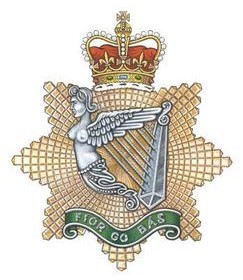Related Research Articles

The 47th Division was an infantry division of the British Army, raised in 1908 as part of the Territorial Force.

The 33rd Division was an infantry division of the British Army that was raised in 1914, during the First World War. The division was raised from volunteers for Lord Kitchener's New Armies, that was originally made up of infantry battalions raised by public subscription or private patronage. The division was taken over by the War Office in September 1915. It served in France and Belgium in the trenches of the Western Front for the duration of the war. The division's insignia was the "double-three" from a set of dominoes.

The Irish Regiment of Canada is a Primary Reserve infantry regiment of the Canadian Army based in Sudbury, Ontario. It is part of the 4th Canadian Division's 33 Canadian Brigade Group. Currently one battalion of the regiment exists.

The 23rd Infantry Brigade was an infantry brigade of the British Army that saw active service in the First World War, mainly on the Western Front During the Second World War, the brigade saw active service in the Syria-Lebanon Campaign, the Western Desert Campaign, and the Burma Campaign.
The 167th Brigade was an infantry formation of the British Territorial Army that saw active service in both the First and Second World Wars. It was the first Territorial formation to go overseas in 1914, garrisoned Malta, and then served with the 56th (London) Infantry Division on the Western Front. In the Second World War, it fought in the North African and Italian campaigns in the Second World War.
The 234th Infantry Brigade was an infantry brigade of the British Army, raised during the First World War, and was later reformed during the Second World War.
The 168th Brigade was an infantry brigade formation of the British Army that saw service during both the First and the Second World Wars. Throughout its existence, serving under many different titles and designations, the brigade was an integral part of the 56th (London) Infantry Division. It served on the Western Front during First World War and in the Italian Campaign during the Second World War. It was finally disbanded in the 1960s.

The 58th Division was an infantry division created in 1915 as part of the massive expansion of the British Army during the First World War. It was a 2nd Line Territorial Force formation raised as a duplicate of the 56th Division. After training in Britain, the division joined the British Expeditionary Force (BEF) on the Western Front in 1917. It saw action at the battles of Arras and Passchedaele in 1917 and the German spring offensive in 1918. It then took part in the Battle of Amiens and the final Allied Hundred Days Offensive of the war. The division was recreated during the Second World War, as an imaginary deception formation.
The 2/1st London Brigade was a 2nd Line formation of the Territorial Force of the British Army. It was formed at the start of World War I and served in overseas garrisons in Malta and Egypt. Although it never saw action as a formation, its constituent battalions fought at Gallipoli and served against the Senussi tribesmen. The brigade was then sent to the Western Front where it was broken up to provide drafts for 1st Line units.

The 140th Brigade was an infantry brigade formation of the British Army's Territorial Army (TA) that had its origins in a South London Brigade of the former Volunteer Force. It served on the Western Front in the First World War and was recreated during the Second World War where it served only in the United Kingdom as a training formation.
The 142nd Brigade was an infantry brigade of the Territorial Army, part of the British Army, that served in the First and the Second World Wars, and remained in the United Kingdom throughout the latter.
The 169th Brigade was an infantry brigade of the British Army that saw active service in both the First and the Second World Wars. Throughout its existence the brigade, serving under numerous many different titles and designations, was an integral part of the 56th (London) Infantry Division. It served on the Western Front in the First World War, and in the North African and Italian campaigns during the Second World War.
The 173rd Brigade was a formation of the British Army's Territorial Force that was raised in 1915. It was assigned to the 58th Division and served on the Western Front during the First World War. Its number was used for a deception formation during the Second World War.
The 175th Brigade was an infantry brigade formation of the Territorial Force of the British Army. The brigade was formed as a 2nd Line of the 169th Brigade and was assigned to the 58th Division, itself formed as a 2nd Line of 56th Division, and served on the Western Front during the First World War.

The Finsbury Rifles was a unit of Britain's Volunteer Force and later Territorial Army from 1860 to 1961. It saw action at Gallipoli, in Palestine and on the Western Front during the First World War. In the Second World War, it served in the Anti-Aircraft (AA) role during the Battle of Britain and the Blitz, then in North Africa, Sicily and Italy.

The Capture of Wurst Farm was an attack by the British 58th Division against the German 36th Division on 20 September 1917, near Ypres, Belgium, during the Battle of the Menin Road Ridge, part of the Third Battle of Ypres. Wurst Farm was at the lower end of Gravenstafel Ridge and several British attacks in the area since 31 July had been repulsed by the Germans. The British began a desultory bombardment on 31 August and the shelling became intense from 13 September, to "soften" the German defences, except in the area of the Fifth Army, where the slow bombardment continued until 24 hours before zero hour, when a surprise hurricane bombardment was to be fired.
The 4th Battalion, London Regiment was a Volunteer unit of Britain's Territorial Army (TA) recruited from East London. During World War I it raised four battalions, which carried out garrison duty in Malta and Egypt, served at Gallipoli and against the Senussi, and saw a great deal of action on the Western Front, notably in the Attack on the Gommecourt Salient in 1916, at Bullecourt in 1917 and at Oppy Wood and Chipilly Ridge in 1918. During World War II it served as an anti-aircraft regiment in the Battle of France and during the Blitz in 1940 and in North West Europe in 1944–45. It continued in the TA until 1961.
The 3rd Battalion, London Regiment was a volunteer unit of the British Army under various titles from 1860 to 1961. Originally raised from railwaymen, the battalion sent a detachment to the Second Boer War and several battalions fought in World War I. Shortly before World War II, it became a searchlight unit and defended the UK during the Blitz, remaining in the air defence role in the postwar Territorial Army.
The 2nd Battalion, London Regiment was a volunteer infantry battalion of the British Army under various titles from 1860 to 1961. It served in Malta, Gallipoli, Egypt and on the Western Front during World War I. In World War II it saw service in Iraq, North Africa and Italy. After a postwar spell as an air defence unit, it reverted to the infantry role, and merged into the Territorials of the Royal Fusiliers.
The Structure of the Egyptian Expeditionary Force over the course of the First World War is shown below.
References
- ↑ "58th (2/1st London) Division". The Long Long Trail. Retrieved 4 February 2012.